Winning the race for cleaner oceans with analytics
Jean Pauphilet and his PhD student on the dynamic algorithm they’ve created to tackle one of the world’s most pressing environmental issues

In the North Pacific Ocean, halfway between Hawaii and California, there are 80,000 tonnes of spinning plastic debris. Welcome to the Great Ocean Garbage Patch – an area twice the size of Texas, and triple the size of France or Thailand. It looks as catastrophic as it sounds: from above, it resembles a gigantic plastic soup.
The Great Ocean Garbage Patch is one of five subtropical areas (known as “gyres”) where massive circular currents trap floating plastic for decades. The oldest pieces in this gyre have been found to date back to the 1960s.
Discover fresh perspectives and research insights from LBS
It gets worse: millions of tonnes of plastic waste flow annually into the oceans – and these yearly emissions could triple by 2040, according to the World Economic Forum. The cost to our ecosystems, health and economies is off the scale, with the overall financial damage to marine ecosystems standing at US$13 billion a year. Another disturbing prediction: plastic could outweigh fish in the oceans by 2050, says the WEF. Meanwhile, marine life is bearing the brunt of the consequences: entanglement, strangulation and ingestion impacts fish, turtles, seals, crustaceans, whales and thousands more endangered species. While for humans, exposure to plastic can affect fertility, hormonal, metabolic and neurological activity.
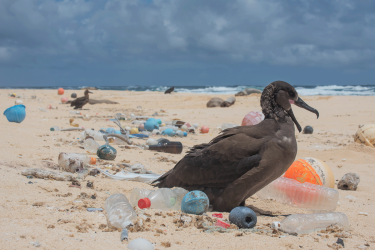
Photo: A bird surrounded by ocean plastic on the Northwestern Hawaiian Islands. Photo courtesy of Matthew Chauvin.
Image credit: The Ocean Cleanup
Fishing for rubbish
What is being done to detonate this ticking time bomb? In March 2022 the United Nations announced that 175 nations had agreed to forge a legally binding agreement on plastic pollution by 2024. This is a significant and welcome milestone, but is anything being done right now?
The answer is yes. Since 2013, a Dutch nonprofit called The Ocean Cleanup has been working towards eliminating plastic in rivers and oceans, with a mission to clean up 90% of floating ocean plastic by 2040. Funded mainly by donors, their ocean work is currently focussed on the Great Pacific Garbage Patch – the most polluted and well-researched of the five gyres.
To capture the plastic, they have developed a game-changing technology that resembles a gigantic fishing net. Instead of catching fish, it catches rubbish. The system consists of a long floating barrier which is towed through water by two small vessels. The barrier is open at the bottom, allowing marine life to escape. As it moves through the water, plastic is collected in a huge retention zone, later to be emptied out on deck. It is then separated into different streams and packaged up for recycling. The plastic is processed or transformed into durable new products – nothing goes to waste.
A good fit
The Ocean Cleanup has proved that the technology works; now it is important to make the operation as efficient as possible. Plastic degrades and sinks, so the faster it can be collected, the more can be collected. Therefore, they required a better steering strategy – one which takes into account navigation conditions, and anticipates the locations and movement of the plastic.
This is where London Business School comes in – specifically a collaboration with Jean Pauphilet, Assistant Professor of Management Science and Operations, and his PhD student Baizhi Song.
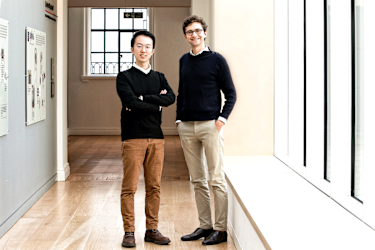
Photo: Jean Pauphilet (right) with Baizhi Song
Jean explains how the collaboration came about. Around March 2022, he and Baizhi started talking with Analytics for a Better World (ABW) – an institute which brings together nonprofits and the academic world. Having seen that the value of analytics remains largely limited to the commercial sector, they decided to facilitate the use and impact of analytics in the nonprofit sector and create a platform to develop research projects that contribute towards the UN’s Sustainable Development Goals.
“I was already collaborating with one of ABW’s co-founders, Prof. Dick den Hertog from the University of Amsterdam, when they got in touch with The Ocean Cleanup. My experience and expertise seemed perfectly aligned with their needs,” says Jean.
For this project, ABW was looking for specific optimisation knowledge to be matched with the expertise and resources of the computational modelling team of The Ocean Cleanup, says ABW's managing director Robert Monné. “So we reached out to our network of like-minded and passionate researchers. We found Jean and Baizhi who were both excited and perfectly skilled to take up this challenge. It's a perfect match,” Robert explained.
Many of Jean’s research projects consist of developing algorithms for large-scale optimisation problems, particularly optimisation under uncertainty, and applying them to real-world problems. Collaborating with The Ocean Cleanup seemed like a natural fit.
“Operations research and analytics have strived in making systems more efficient,” says Jean. “The Ocean Cleanup had already shown their system was effective, so the next challenge is to scale up and accelerate – which is precisely what analytics can help with. When I first heard about the problem, I thought: ‘The input data (weather maps, fluid mechanical models) is really cool, the algorithmic challenge is non-trivial, and the final goal is good for society. Let’s go!’ Being in academia, I view my job as going for the problems that businesses are not naturally incentivised to solve.”
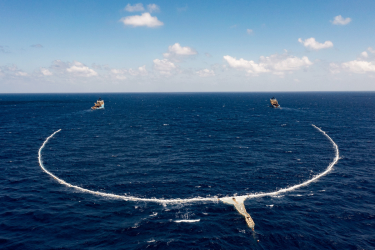
Photo: System 02 deployed for testing in the Great Pacific Garbage Patch
Image credits: The Ocean Cleanup
Playing Pac-Man
“People try to do different things when it comes to ocean-plastic cleaning,” says Jean. “What we’re working on with The Ocean Cleanup is the equivalent of open-air carbon capture for plastic emissions.”
Together with The Ocean Cleanup, Jean and Baizhi set about designing an efficient dynamic algorithm. The team modelled the movement of their ocean-cleaning system over time as a graph. Then they transformed the problem of finding a trajectory that maximises plastic collection into the problem of finding the longest path in a graph. “This is a long-studied problem in the optimisation literature, to which the dynamics of plastic dispersion introduced a new twist,” says Baizhi.
By the end of 2022, Jean and Baizhi had created a first version of their algorithm, which they then iteratively updated to take into account the complex plastic dynamics and to evaluate its impact on rigorous and realistic simulations.
“It’s a bit like playing Pac-Man,” explains Jean. “You need to route the system to catch as many items as possible. The difficulty being that the currents move the plastic around into ever-shifting hotspots. So it’s like an algorithm for Pac-Man when the dots are moving.”
In addition to the system’s trajectory, the algorithm schedules regular emptying of the retention zone, the region of the net where the collected plastic accumulates (the trash bag).
"It’s a bit like playing Pac-Man. You need to route the system to catch as many items as possible"
Emptying the retention zone and sorting the plastic collected takes about one day and requires mild weather conditions, explains Baizhi. “So, it is sometimes better to empty the retention zone early, while weather permits, and then move to more violent, high-wave regions to gather more plastic. That’s one of the reasons why our algorithm improves over their current approach: it makes both decisions, where to go and when to empty, simultaneously.”
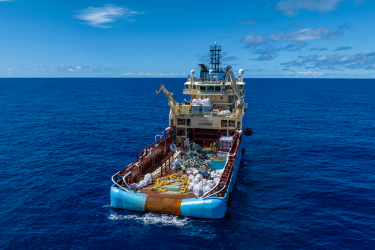
Photo: Plastic catch upon a support vessel.
Image credit: The Ocean Cleanup
Battling the elements to locate the plastic
Their algorithm needs to process a large amount of data, in particular related to wind speed and wave height, to construct a good trajectory for the system. It’s not about going faster, because the floating barrier has to be towed at 1.5 knots (less than 2mph) in order not to catch any fish, explains Jean. “The goal is for the system to be in the right place at the right time. So, we need to account for where the plastic is, where it will be, and how long it will take for the system to get there.”
“We start from the plastic density data,” says Baizhi. “This is not one static map, but rather a sequence of dynamic forecasts, like a video. We also need to take into account weather, such as when the wind is violent, and anticipate and avoid high-wave regions.” The average wave height in winter in the GPGP is around 3.5 metres, says Baizhi, and the cleanup system starts to face some restrictions with any wave higher than 2.5 metres. “At this point, it might be too dangerous to go in certain directions or too difficult to operate the equipment.”
To consider all this data and to find the optimal, or at least, a good trajectory is very difficult, explains Baizhi. “By using analytics, we can process most of this information in a few minutes and synthesise it into a recommended route.”
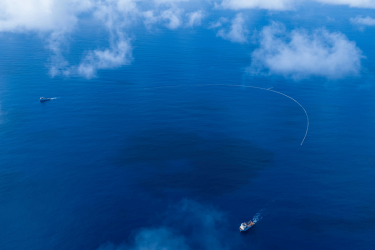
Photo: System 03 deployed for the first time into the Great Pacific Garbage Pitch in August 2023.
Image credit: The Ocean Cleanup
Bigger and better
The Ocean Cleanup’s technology, meanwhile, has come a long way in the past few years. They have developed three “fishing net” systems, each one wider and longer than the last, to harvest more plastic. System 001 (“Wilson”) launched in 2018, System 002 (“Jenny”) in 2021, and System 03 (“Josh”), which they started operating in 2023. With System 03, they aim to deliver the blueprint design for scaling toward a fleet of systems – their goal being to operate up to ten systems. (Fun fact: the systems’ nicknames all come from Tom Hanks films – Wilson is the name of the basketball in Castaway; Jenny is the name of Forrest Gump’s girlfriend, and Josh is the name of Hanks’ character in Big.)
At the start of our collaboration, two years ago, they were operating System 002, which was the 800-metre-long barrier, explains Jean. Last summer, with System 03, they increased the span to 1.4km. “Although they increased the span of the system by a factor two, it does not necessarily mean that their plastic collection will increase by twofold – in particular, because of the need to empty the retention zone regularly. Our algorithm helps them better quantify the relationship between system size and quantity of plastic collected."
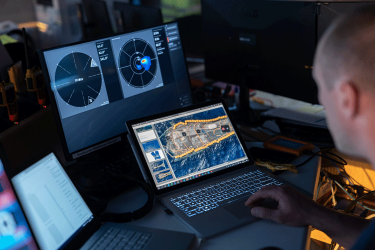
Photo: Crew member onboard the vessel monitoring the process with the help of drone footage
Image credit: The Ocean Cleanup
From strategic decisions to automated steering
The Ocean Cleanup’s research and development team is currently using Jean and Baizhi’s algorithm as part of their simulation tool, a sandbox they use to assess whether it will be worth sizing up their fleet.
“It informs strategic decisions,” says Jean, such as figuring out the impact of increasing the length of the barrier or increasing the size of the retention zone on the collection speed. “We’re all working towards the algorithm being used every day on the ships, as a piloting decision support tool. The aim is for it to be implemented in 2024.”
“On simulations, we’ve estimated that by optimising the trajectory of their system in the Great Ocean Garbage Patch, our algorithm could increase the amount of plastic they collect by an average of 67%.”
Both Jean and Baizhi are happy with what has been achieved so far.
“It’s a successful research project,” says Jean. “And it’s a real applied research project in that the aspects that make the problem scientifically interesting come directly from the particularities of real-world decisions we are trying to inform.”

Photo: Retention zone filled with plastic
Image credit: The Ocean Cleanup
Mission possible?
So far 300 tonnes of plastic have been collected from the Great Ocean Garbage Patch. With System 03, The Ocean Cleanup estimates it would take 10 systems and 10 years to reduce the size of the patch by half.
“We’ve helped them figure out an algorithm to compute their routes, and there’s still a lot of open questions related to adapting the route to new data collected in real-time such as drone footage or to managing a fleet of systems instead of one,” says Jean. “I hope they’ll scale up as much as possible and as quickly as possible.”
Does Jean think that The Ocean Cleanup can achieve its goal to eliminate 90% of plastics floating in the ocean by 2040? “It’s an ambitious mission, in a short amount of time,” he says, “but a lot can be done and is being done to reduce ocean plastic pollution, from bans on single-use packaging to the interception of litter in rivers and harbours.” He’s confident we will see drastic reductions in plastic emissions and pollution within the next 15 years.
“We’ll be working with The Ocean Cleanup for as long as they need us, but to achieve their goal they will need to switch from an R&D mode to full-speed operations. I hope at some point they won’t need us any more!”
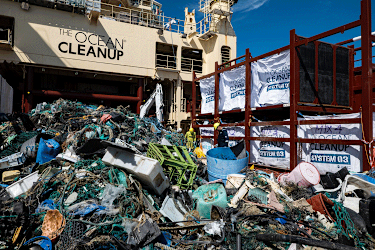
Photo: Plastic catch onboard the support vessels of System 03.
Image credits: The Ocean Cleanup
Making waves
It's amazing to see the amount of work and progress that has been made so far, says ABW's Robert. "After the first phase we already saw a prototype which had an impressive (simulated) performance improvement. The research team works now closely with the computational modelling team of The Ocean Cleanup to further improve the model and steering strategy,” he explained.
For Baizhi, his work with The Ocean Cleanup has surpassed his expectations. He admits when he first heard about the idea, he didn’t think it would be possible to make the ocean clean again. “In the two years that we’ve been working with The Ocean Cleanup they’ve evolved quickly, and so have we. As a researcher, I wish our algorithm could be deployed in their ships right now, but in practice, many implementation bottlenecks need to be addressed, and we need to progress step by step.”
Looking at the big picture, Jean is sanguine about The Ocean Cleanup project. “It’s important to realise the extent of the mess we’ve created in parts of the world where we’ve barely set foot,” he says.
“You need an NGO like The Ocean Cleanup to raise awareness of these problems. Cleaning up oceans from plastic may sound like a distant dream, but by working with them, you become really convinced that this dream can come true.”
Jean Pauphilet is Assistant Professor of Management Science and Operations at London Business School. Baizhi Song is a PhD student at London Business School.
Bruno Sainte-Rose, Lead Computational Modeler at The Ocean Cleanup, provides more insight on how the collaboration with London Business School and its algorithm maximises ocean clean up.
Read more









